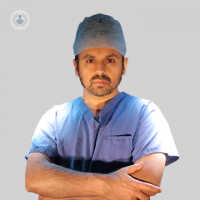Over in a blink of an eye: pioneering techniques in glaucoma surgery
Escrito por:For the last 50 years, experts have been treating severe glaucoma with an operation called a trabeculectomy. But that looks set to change thanks to a brand new treatment which has just reached the UK. We spoke to expert ophthalmologist Mr Imran Masood, who introduced the treatment, to find out what patients can expect...

How is severe glaucoma traditionally treated?
When a patient has glaucoma and they haven’t responded to eye drops or laser treatment, surgery is often recommended.
The most common procedure offered is called a trabeculectomy. This involves making a cut in the eye to deal with the excess fluid that’s causing pressure in the eye, and let it drain out.
This procedure can take about an hour, and often requires putting the patient to sleep. It also requires cutting a small drainage hole in the white of the eye under the upper eyelid. Although generally more successful than laser treatment or eye drops, the operation can scar resulting in the need for further surgery to remove the scar tissue.
What is the new treatment that you’re offering for glaucoma?
The new procedure is called a GATT (Gonioscopy-Assisted Transluminal Trabeculotomy). It was pioneered in Texas and after observing and mastering the technique over the past year, I am now able to offer the procedure in the UK.
To drain the excess fluid from the eye, we pass in a catheter just 1mm thick. This goes into and dilates Schlemms canal, it then removed using a technique which creates a “360 degree” trabeculotomy i.e removes the barrier to fluid flow into Schlemm’s canal. This essentially makes use of the eye’s natural drainage system with minimal incisions made.
The full procedure takes just 15 minutes, and the patient is awake throughout. Some of our patients have been surprised when told that the procedure was already over. It’s a day case procedure, so you can go home the same day.
Where is the treatment available?
Our clinic in Birmingham is the only place in the country that offers the procedure. We are aiming to train other surgeons in this procedure and are confident that take-up will be significant, given the success rates we’re seeing.


